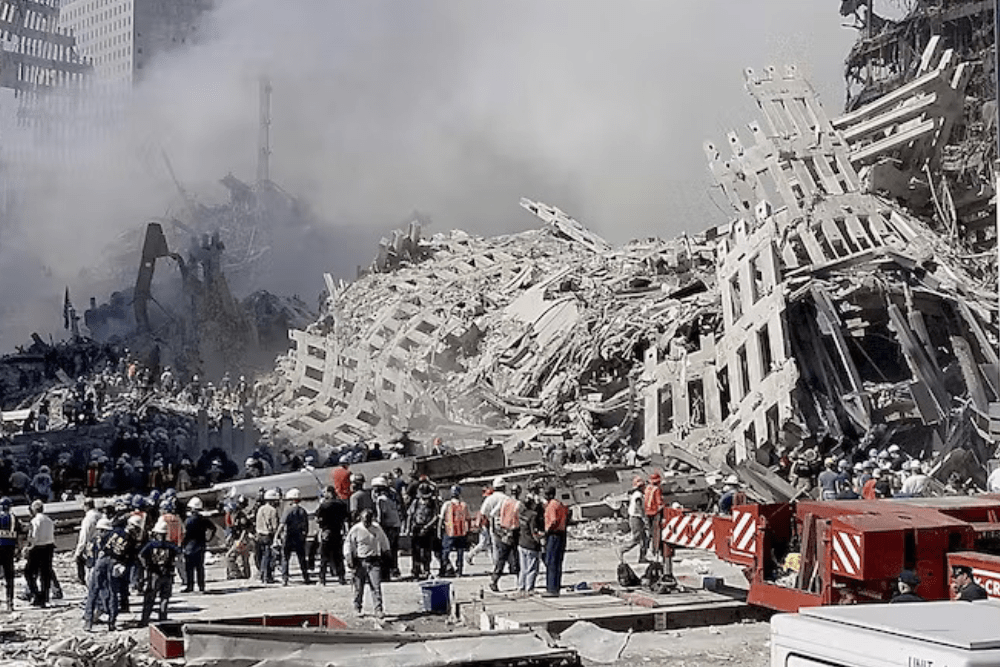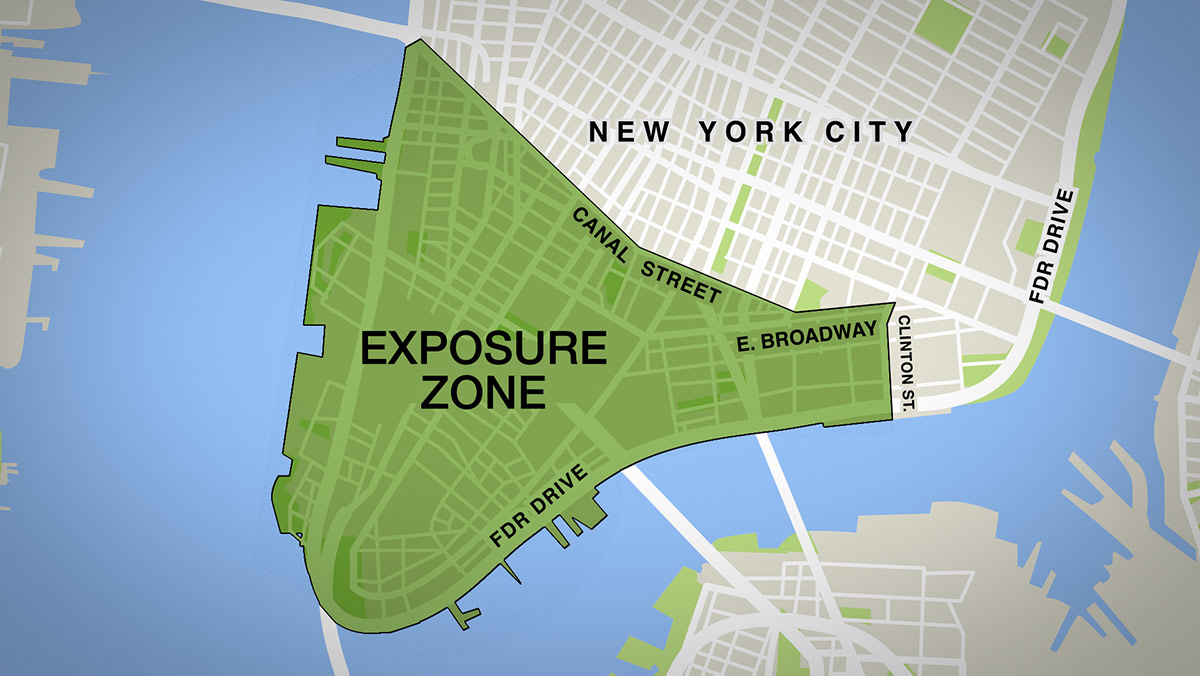
What Was the Air Quality like on 9/11?
Despite assurances at the time, when the Twin Towers fell on that fateful September morning in 2001, the resulting air pollution caused by the disintegration of the buildings and the ensuing fires spread toxic particles and fumes across a wide area of New York, New Jersey, and beyond. Increased levels of air pollution and particulates were measured as far away as Windsor, Canada, six months after the attacks. As the 9.11 World Trade Center Health Program concluded:
The collapse of the Twin Towers created massive dust clouds that filled the air and left hundreds of populated city blocks covered with ash, debris, and harmful particles.
What Hazards Resulted from the Collapse of the Twin Towers and the Pile Burn?
Aerial photographs revealed the extent of the spread of a toxic cloud that began on September 11th. At the site, first responders, workers, residents, students, and families were immediately exposed to toxic gases, smoke, vapors, and combustion by-products of the collapse and lingering fires at the pile. These toxins spread far beyond lower Manhattan.
Finally, in 2018 the Centers for Disease Control—CDC—published a shocking inventory of toxic agents unleashed by the terrorist attack. This inventory divides the hazards that first responders, workers, and residents in the vicinity experienced into a variety of categories:
- Chemical
- Physical
- Biological
- Other hazards, including psychological and environmental
However, the Inventory excludes any information about the magnitude of exposure to each of these hazards. And obviously, not all first responders and residents in the immediate vicinity were exposed to all these agents in any significant way.
The list of chemical “9/11 agents” was compiled from a review of studies conducted afterwards. Chemical agents were defined from a review of air and settled dust studies and biological monitoring. In all, 352 toxic 9/11 agents were identified and substantiated, although it is impossible to measure the exact exposure to which chemicals occurred.
What Conditions Are Covered by the World Trade Center Health Program?
Certainly, 9/11 forever impacted the nation, but individuals living and working around Lower Manhattan; Shanksville, Pennsylvania; and the Pentagon were exposed to far more. Federal legislation to provide compensation to first responders and survivors has evolved over the years as more evidence of the consequences of exposure has been identified and cataloged.
A range of medical and psychological conditions qualifies first responders, workers, and residents for federal assistance. If you have any of these conditions, you might qualify for monitoring, medical treatment, and other financial assistance. However, to receive these benefits, you must apply. Only certified WTC health-related conditions are covered.
- Acute Traumatic Injuries: these include burns, complex sprains, eye injuries, fractures, head traumas, tendon tears, and other physical injuries
- Airway and Digestive Disorders: these include a range of disorders that affect breathing airways, affecting sinuses or lungs and upper digestive tract: asthma, chronic cough, rhinosinusitis, pulmonary disease, sleep apnea, and upper airway hyperreactivity
- Cancers: these include breast, childhood, digestive, ovarian and uterine, prostate, skin, and thyroid, among others
- Mental Health Disorders: these include acute stress disorder, anxiety, depression, panic disorder, substance use disorder, and post-traumatic stress disorder
- Musculoskeletal Disorders (for first responders only): these include carpal tunnel syndrome, lower back pain, and other skeletal disorders
In addition to requiring a certified WTC health-related condition, some airway and digestive health conditions must meet a requirement called a maximum time interval. This is the maximum amount of time that could have gone by between the date of the last 9/11 exposure and the onset of symptoms of an airway or digestive condition. These time intervals range from 1-5 years depending on the condition.
To qualify as a certified cancer, minimum cancer latency requirements exist. Latency is the amount of time that has passed between initial 9/11 exposures and the date of diagnosis. These minimum latency requirements range from .04 years for certain blood cancers to 11 years for mesothelioma.
How Do I Apply for WTC Health Program Benefits?
There are three steps to determine eligibility for WTC Health Program benefits.
Am I a Member of a Covered Group? Four groups of people affected by the 9/11 attacks qualify for benefits.
- FDNY responders
- WTC general responders
- WTC survivors who lived, worked, or went to school in the NYC Disaster Area
- Pentagon/Shanksville, PA responders
The full eligibility criteria for membership in any of these groups is defined by the James Zadroga 9/11 Health and Compensation Act of 2010.
What Documentation Will I Need? To establish membership in either a survivor or responder group, you will need specific types of documentation to place you within the Disaster Areas during relevant time periods to establish actual exposure.
Complete a WTC Health Program Application: First responders and survivors can benefit from medical treatment and monitoring provided by the WTC Health Program. But you must apply to receive these benefits. It is often confusing and frustrating to gather the necessary documentation and complete the application. This is where Weisfuse & Weisfuse, LLP can help.
Contact Weisfuse & Weisfuse, LLP Today
When facing the future with chronic or serious medical or psychological issues, you can rely on the compassionate and effective representation offered by the legal team at Weisfuse & Weisfuse, LLP. We provide rigorous and informed legal services to those seeking compensation under the WTC Health Program, as well as the other 9/11-related compensation funds: The Zadroga Act and September 11th Victims Compensation Fund. Let us help you qualify for the benefits you deserve. Contact Weisfuse & Weisfuse, LLP at 212-983-3000 for a free and confidential consultation.






